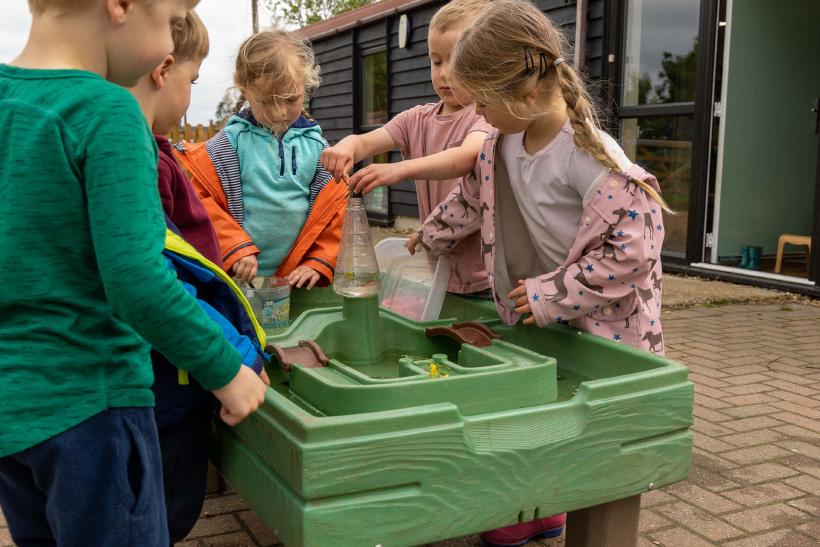Before childhood existed
Centuries ago there was no idea of childhood as a separate notion. Children were born and seen as younger people, they were dressed as adults and treated as such. They contributed to family life as they could, gathering food or water, caring for livestock or younger or sick relatives. Then in Victorian times they became a resource that could work outside the home which in turn led to the view of this as exploitation.
In response the view of childhood in the western world as a time for assimilating knowledge and skills have led to play, not work, being viewed as vital to early childhood learning. This has in turn led to the creation of play based environments furnitured with toys, some of which little resemble adult tools. Children are also removed from many of the responsibilities that other cultures expect of children which leaves them more freedom for formal and informal education.
Then came the Play Theorists
These people looked at how children were treated and how they learned and came up with ideas and reasoning which still underpin much of how we see children’s learning today.
Each week I will cover different strategies which you can use at home with your own children but this week I thought I would talk about some of those pioneers who started to think about child development.
They didn’t reinvent the wheel but they did help our understanding of it
Many of the play practices we will cover will be familiar to generations of people, they are letting children play with and learn from everyday objects in a way that gives children time to really explore the possibilities of simple open ended resources. Your parents and grandparents will know this, they know that a child would often rather play with the box a toy came in rather than the toy itself.
The different ideas about play, from Treasure Baskets to Loose Parts are nothing new for children. These themes have been researched by people who are interested in how children learn and they have assessed what, how and why children learn when allowed to play like this. The rationale behind this is interesting and helps inform parents and carers but it is only a support for your instinct.
Trust yourself and your child, if they enjoy playing with something, they are learning and you can support and extend that learning with good communication and observation. So have fun with your child, really focus on them and see what they like and treat some playtimes as though they were the most important seminar of your degree, or the best training session you have ever been on.

Here are a few of the people who have inspired us:
Jean Piaget 1896 - 1980
He was the first psychologist to make a systematic study of children’s cognitive development. His theory of cognitive development viewed play as integral to the development of intelligence in children. His theory of play argues that as the child matures, their environment and play should encourage further cognitive and language development.
Lev Vygotsky 1896 – 1934
He was probably the first modern day theorist to fully consider the meaning and value of play in children’s lives, and to recognise how the learning that occurs as a result of children’s participation in play is ‘socially constructed’ – that is, their learning does not occur in isolation from their surrounding environment, which includes places, things and, perhaps most importantly, people.
He encouraged us to accept the individuality of children. He asserted that the potential of each child is inextricably tied up with those around him (adults and children), and it follows that such interplay with others is unique to each child. He named this concept the Zone of Proximal Development (ZPD).
Susan Isaacs 1885- 1948
She was a philosopher and psychoanalyst who did her Masters at Newnham College and was head at Malting House School in Cambridge. The school fostered the individual development of children. They were given greater freedom and were supported rather than punished. The teachers were seen as observers of the children who were seen as research workers. Her work made play a central part of a child’s education. Isaacs strongly believed that play was the child’s work.
One memorable story from the school is that when the school’s rabbit died the children held a funeral and buried it. Then 6 weeks later they were curious what had become of it and were allowed to dig it up again.
Maria Montessouri 1870 – 1952
She believed that children are naturally curious and that they learn best when they are allowed to lead and chose activities in an environment that gives them the resources they want. Again the children take the lead and the adults watch, so if your child climbs, make a way for them to climb safely, if they throw then help them do it appropriately by providing missiles such a bean bags and a target, like a laundry basket.
She wanted each child to be treated as an individual and allowed to progress at their own rate unlike traditional educational models which group children into developmental ages and stages. Where planning is done for the collective and reaching milestones is more inflexible.
Rudolf Steiner 1861 to 1925
He was a social philosopher who set up his first school in 1919 for the children of the factory workers he had been employed to educate. The factory owner wanted a full integrated non-denominational school and this caught on as a model for many schools around the world.
Steiner believed that children should be exposed to real-life experiences, cooking, cleaning, sewing and gardening, and that this contributed to their well-being. He that educating a learner’s will and feelings is as important as intellectual advancement. In this way his theory of education is considered ‘holistic’. His approach to early years education encourages child-led, fantasy-based imaginative play, stimulated by natural resources.
















